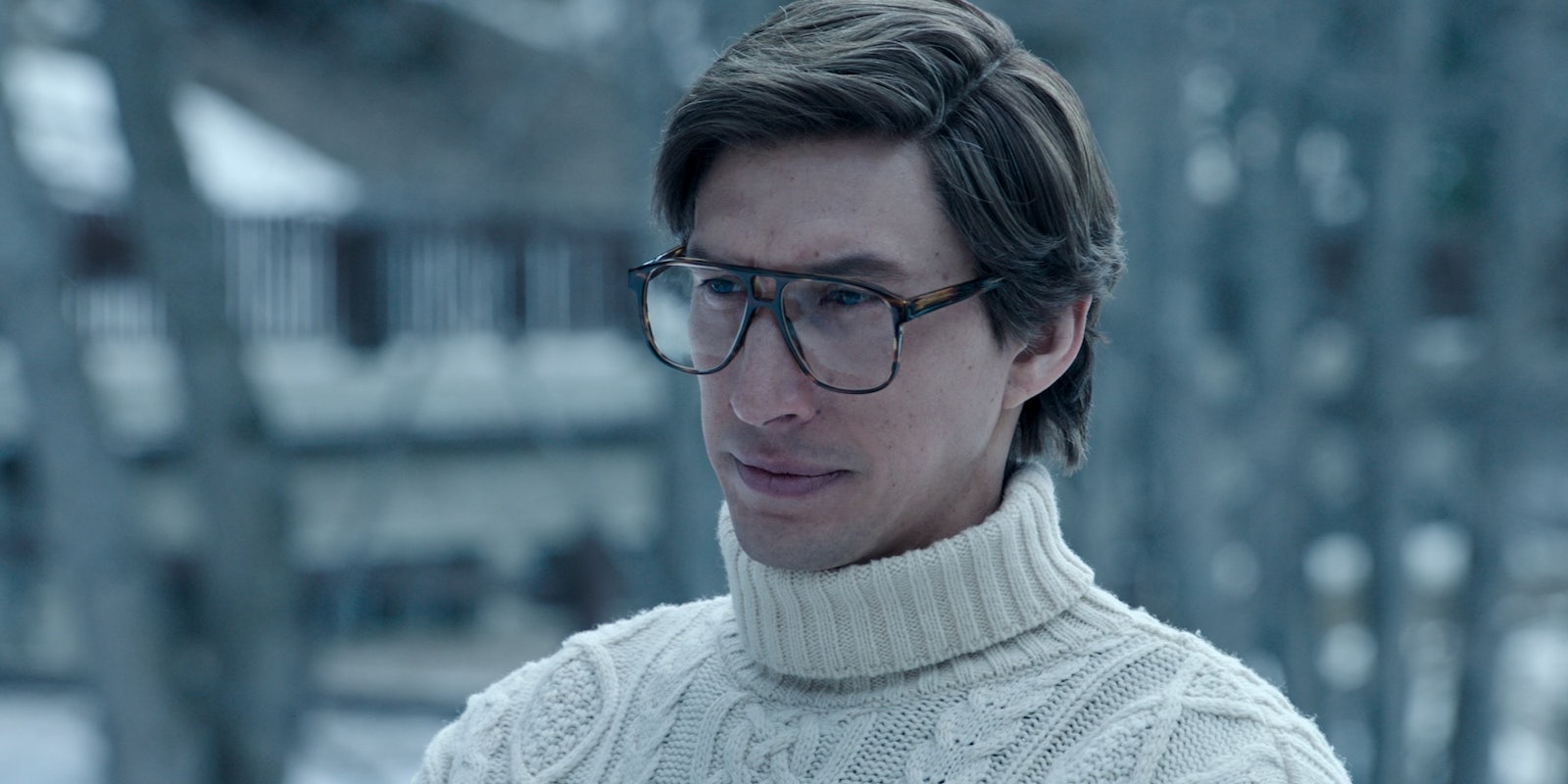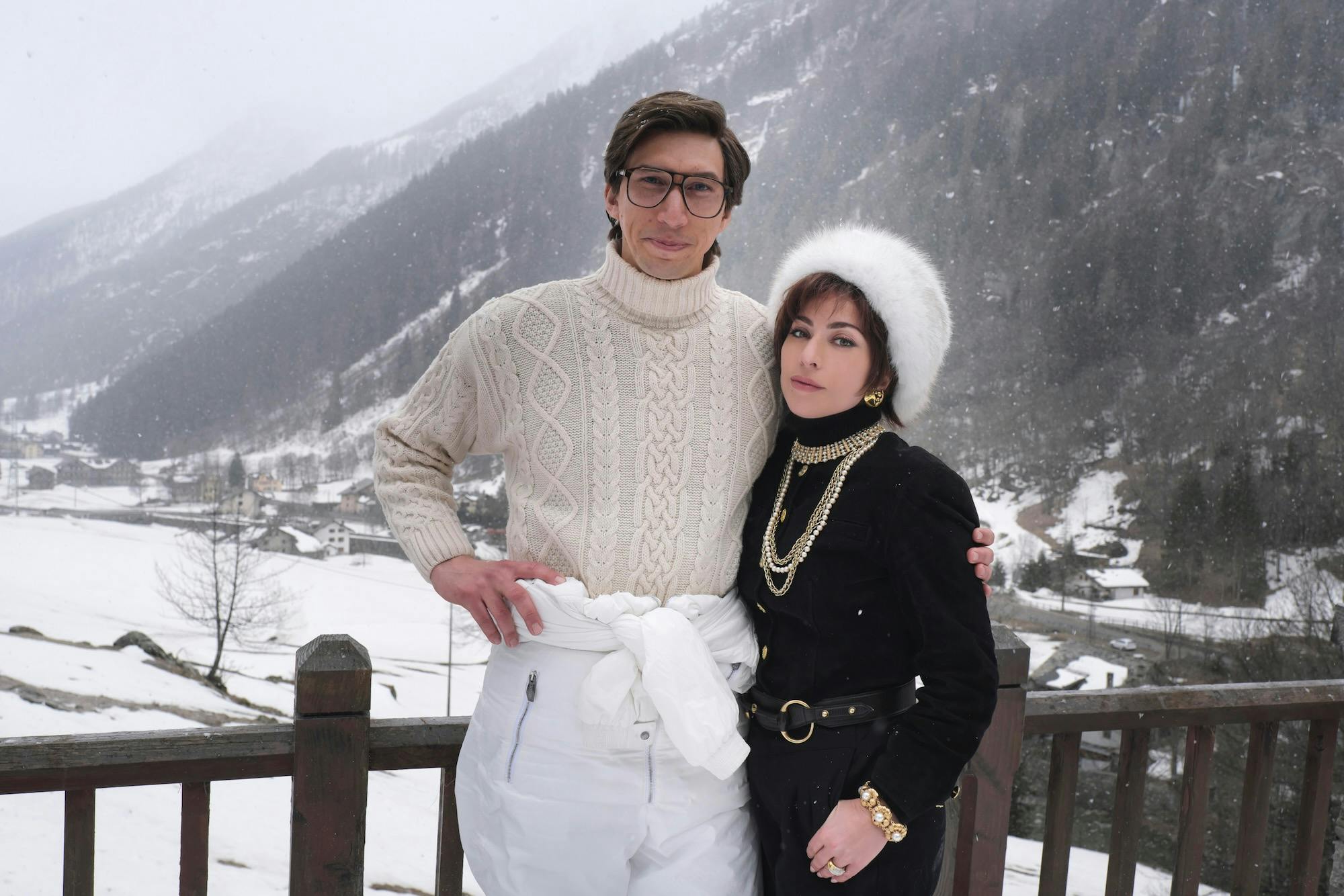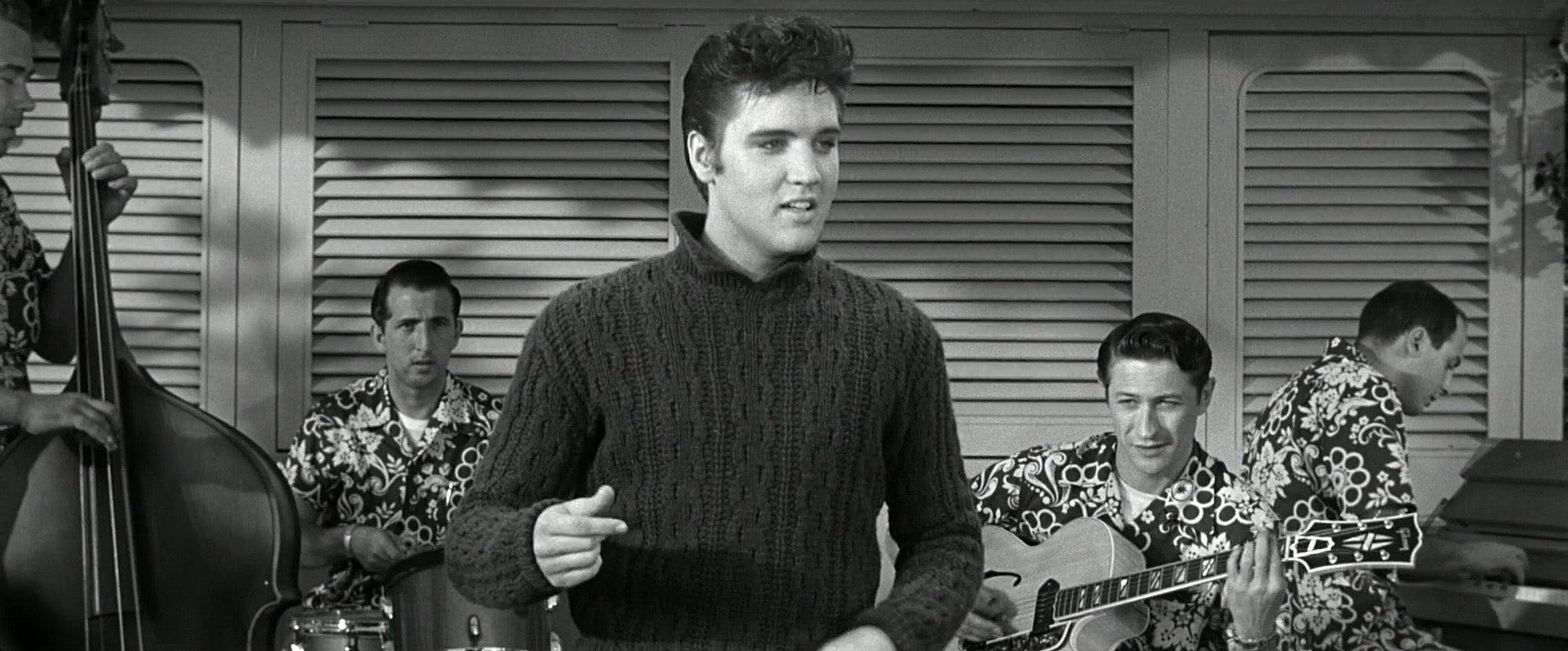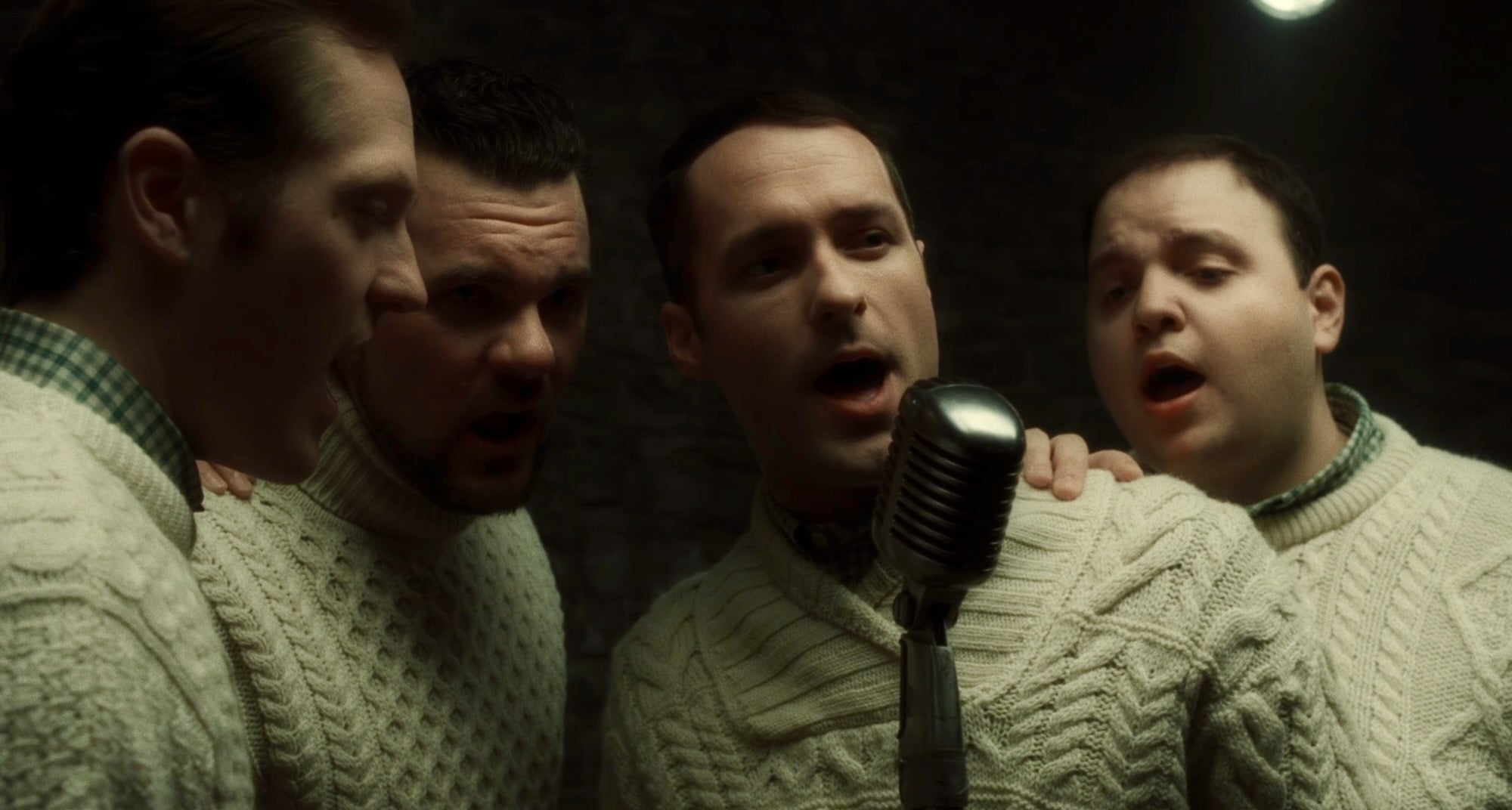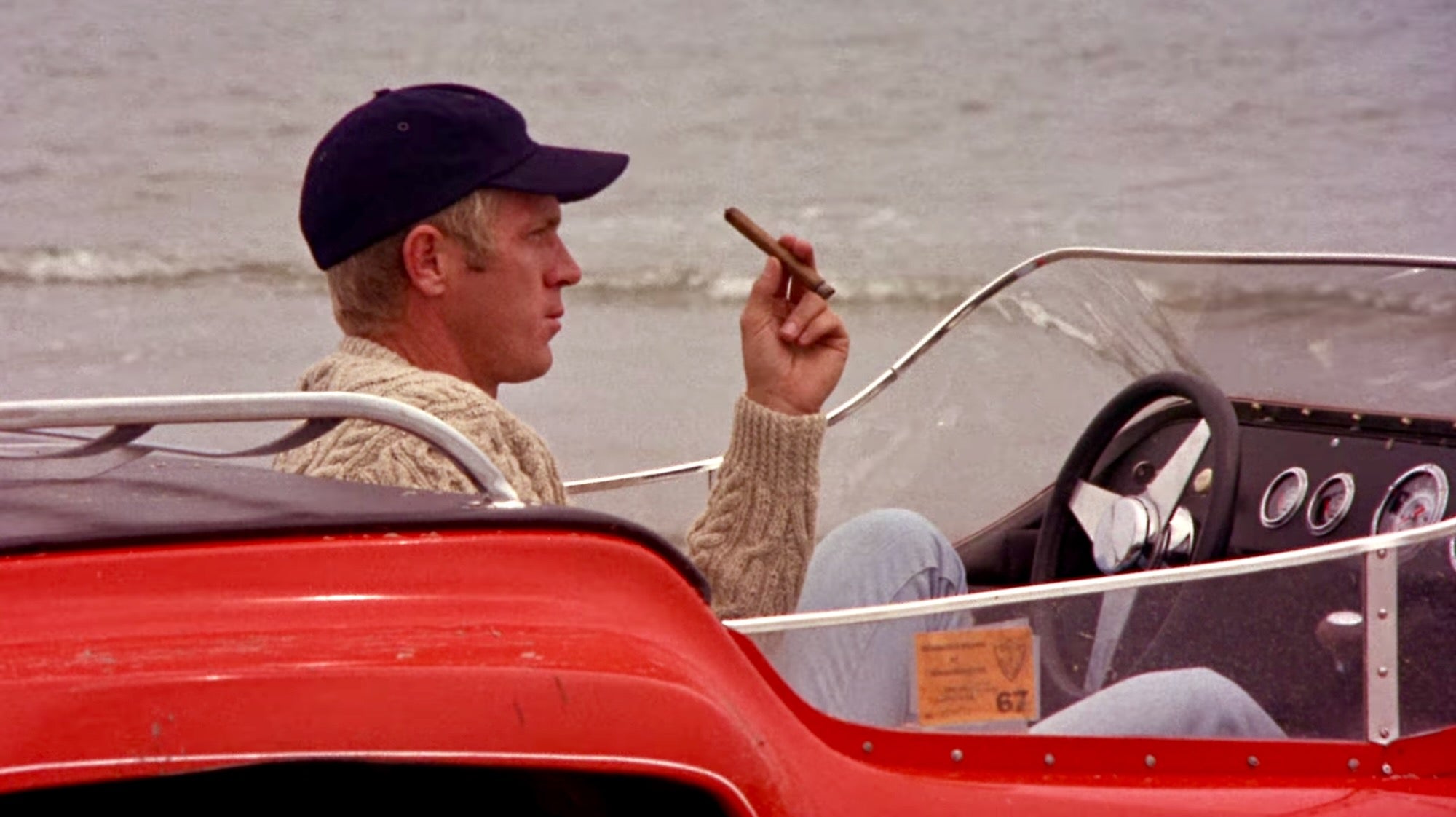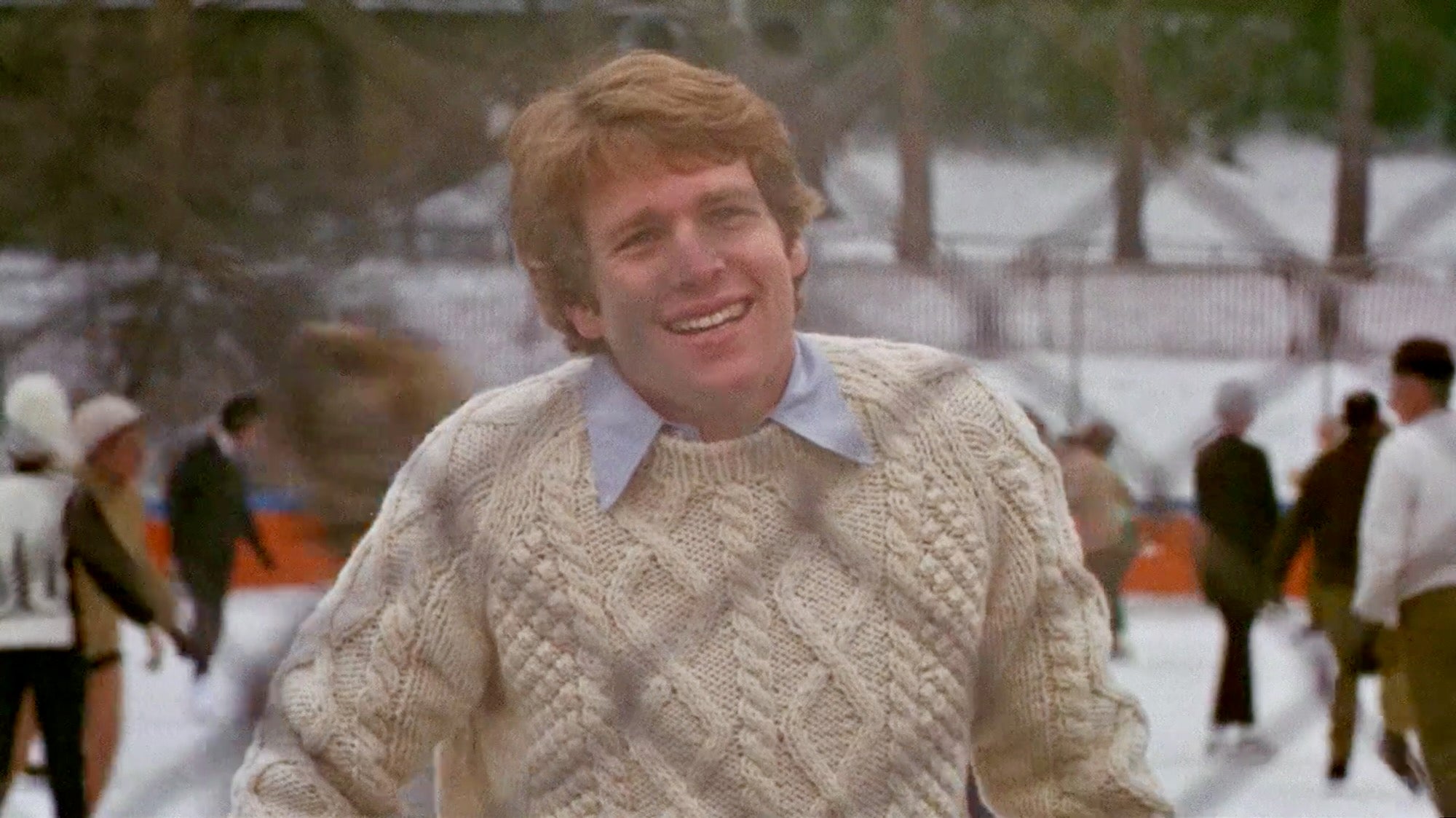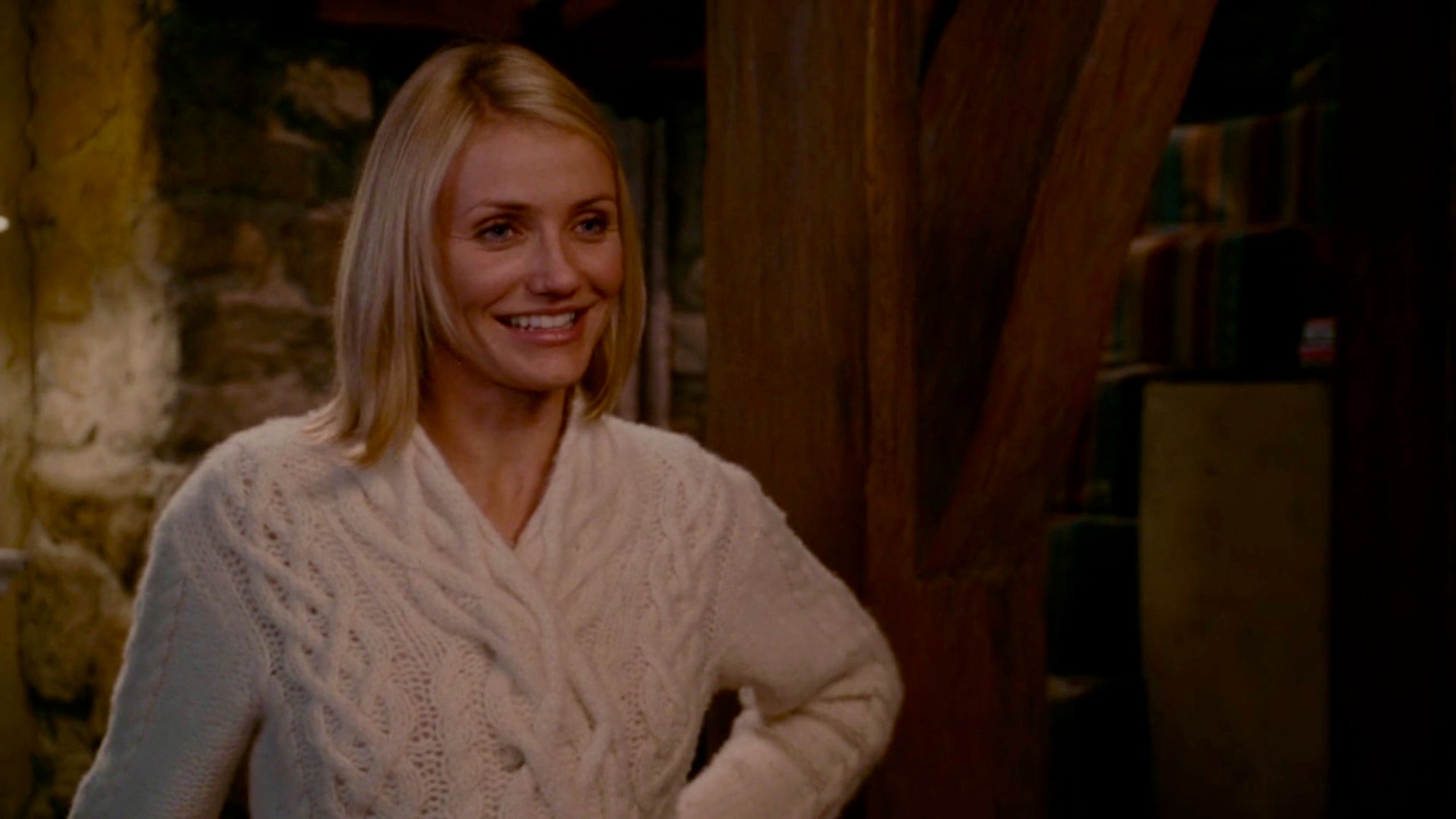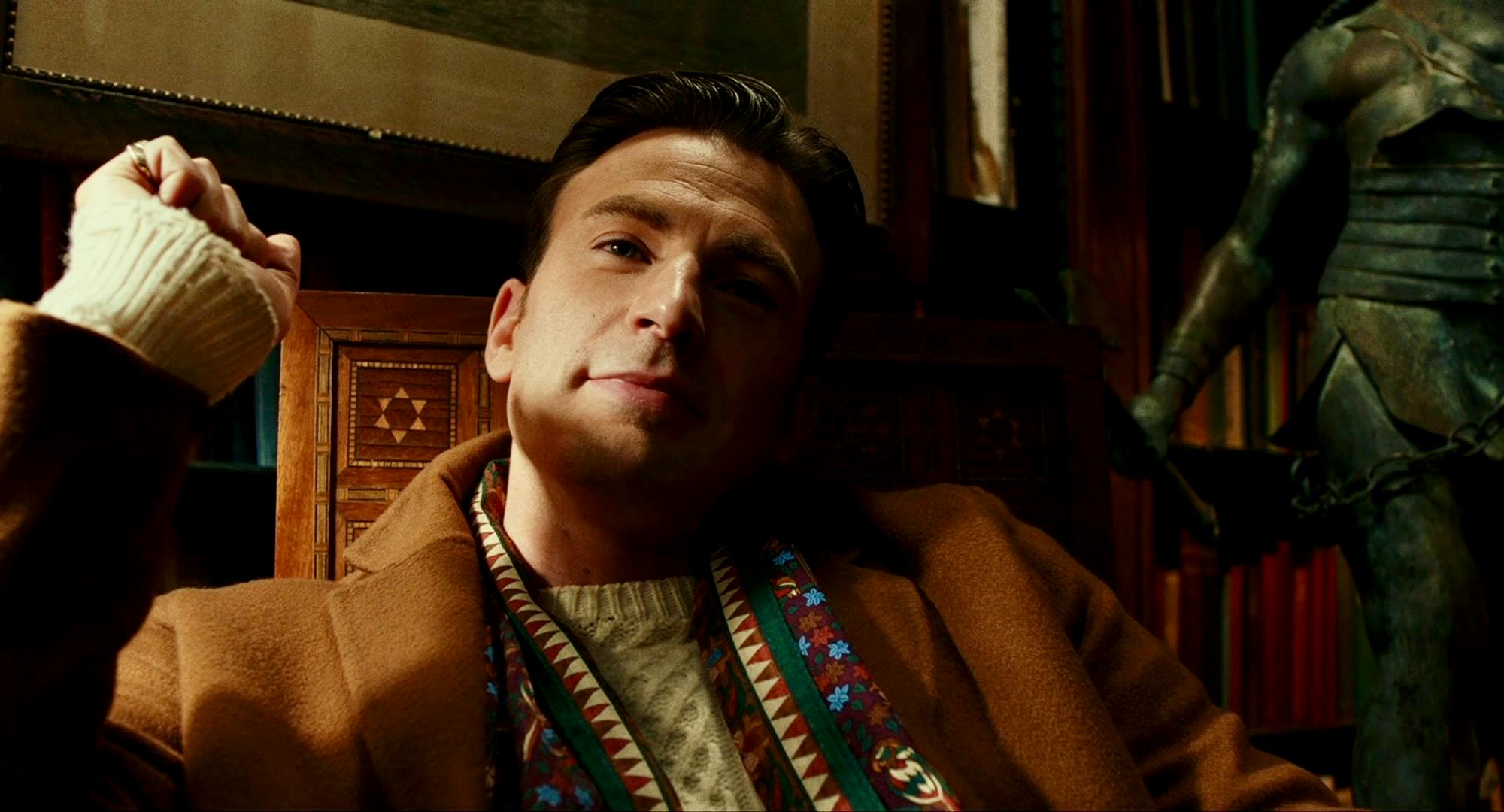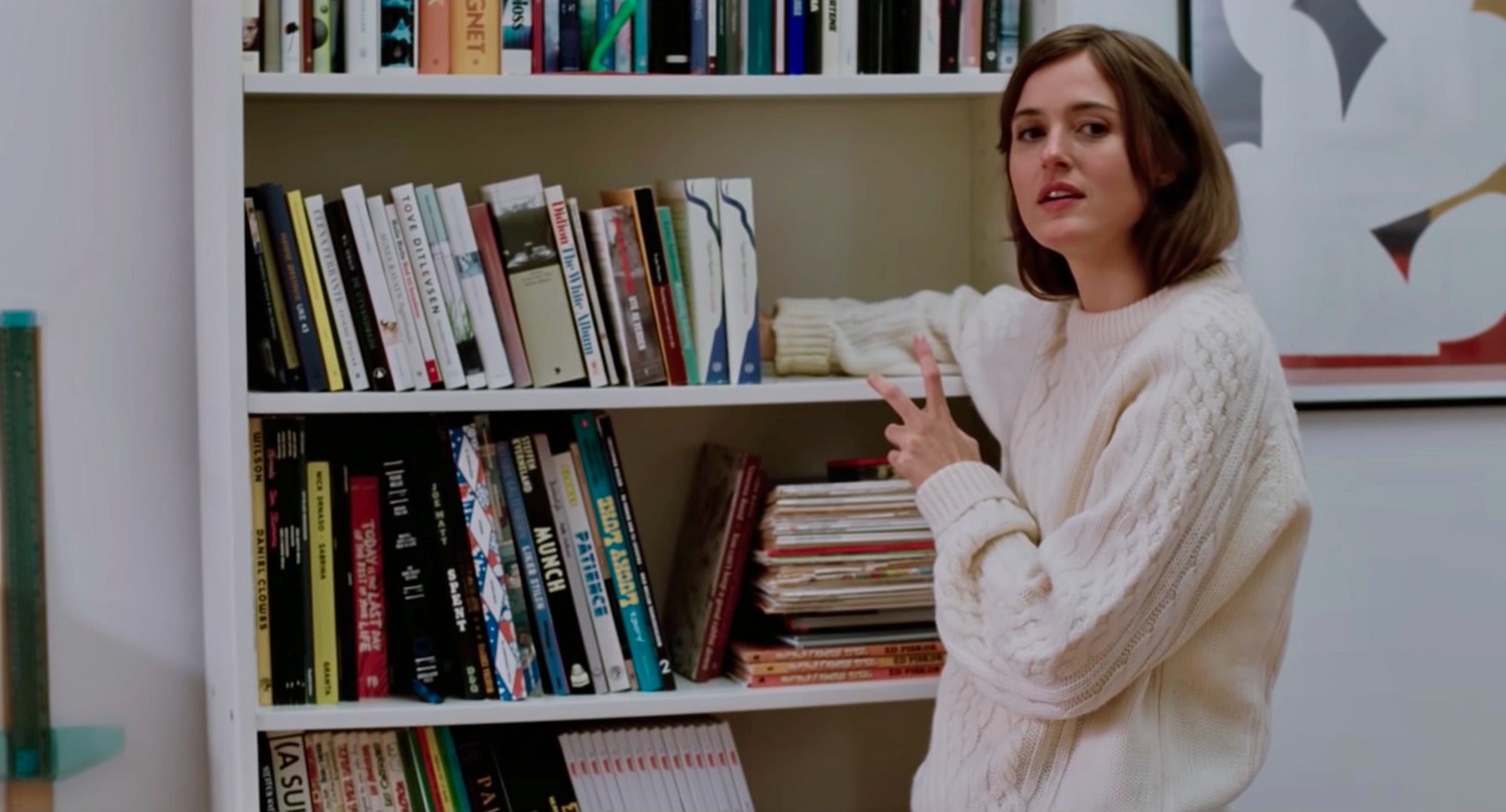This article contains minor spoilers for House of Gucci.
A little more than halfway through Ridley Scott’s lavish drama House of Gucci, a film that’s become as renowned and notorious for some of its performances as its expansive wardrobe, a garment first teased more than eight months ago finally makes its grand entrance.
By the time that Patrizia Reggiani (Lady Gaga) joins her husband Maurizio Gucci (Adam Driver) at their chalet in St. Moritz, Switzerland, where he fled by motorcycle to avoid being arrested by Italian authorities, their hold on Gucci’s fashion house is starting to crumble. But the Swiss holiday also shows us the beginning of their end. At a ski resort, Maurizio, dressed in an all-white ski suit, happens upon his childhood friend Paola Franchi (Camille Cottin) on the slopes. Patrizia, dressed in black furs, a cashmere turtleneck, several gold necklaces, and a white fur hat, arrives at the ski resort and finds herself out of sorts with the crowd who was born into wealth. She embarrasses herself by telling a rambling story about the Eiffel Tower, and when Maurizio calls her out for adding unnecessary details to her story, she responds by telling him that “You’re an unnecessary detail.” Their holiday only goes downhill from there.
Throughout that scene, Maurizio’s jacket is now tied around his waist, revealing the garment that, for several months, was House of Gucci’s viral calling card: a white turtleneck Aran sweater. The sweater—one adorned with diamond trellises, honeycombs, horseshoe crab cables, ribbing at the neck and sleeves, and a plaited cable in the center, which all give the sweater a three-dimensional and textured look—appears to be thin enough to the naked eye that it probably wouldn’t keep Maurizio warm on its own. But when you’re cozied up at the ski lodge and sipping espresso with old friends, your future girlfriend, and your soon-to-be-ex-wife, it more than does the job. Plus, the sweater, which is far from the only sweater in the scene at hand, also fits right in with the luxurious lifestyle that House of Gucci, even sight unseen, exuded.
It was this image of Gaga and Driver posing like a couple on vacation that Gaga posted to give the world the first look at House of Gucci, which depicts the end of a fashion dynasty and Maurizio’s 1995 murder after Patrizia hired gunmen to kill him. The image instantly went viral and was swiftly memed. Sure, some of it had to do with who was wearing the sweater, but the internet was talking about the Aran sweater just as much as they were about Driver wearing it.
For more than four months, up until the first trailer came out in late July, it was one of the only glimpses of the movie we had, along with photos of Gaga feeding Driver in another scene. Since then, our collective attention has largely gravitated towards the dozens of outfits Gaga’s Patrizia wears throughout the film, particularly a red ski suit she wears soon after this scene; even a cashmere throw that Jeremy Irons’ Rodolfo Gucci wears in an outdoor scene got a noticeable reaction at my press screening. But the sweater still left its mark, with numerous people donning Aran sweaters and glasses to dress as Maurizio (and with a Patrizia at their side) this Halloween.
“There were hundreds of them all in Aran sweaters of one sort or another and ski pants and fur hats and black polo necks, it was quite extraordinary,” Janty Yates, House of Gucci‘s costume designer, told the Daily Dot regarding the Halloween costumes. “I had no idea until a photoshoot we did in Milan where the photographer said, ‘Did you know that it has its own webpage? Can we have it? We don’t want anybody in it, we just want the photo of it.’ Very bizarre, but kind of lovely in a way.”
So how did that sweater end up on the big screen? According to Yates, “It was really the one that [Driver] felt the most comfortable in.”
The white Aran sweater, like much of Driver’s wardrobe in House of Gucci, was made especially for him. Yates had about 10 different turtleneck sweaters in different styles—Fair Isle and Shetland among them—and ordered sweaters from knitters in the Shetlands who make them by request. But the custom knit was also a necessity: Because of Driver’s build (a large chest and a smaller waist, according to Yates), it was hard finding a sweater that fit him the way it needed to. Some of the sweaters came down to Driver’s knees, some were too short, and some had the same measurement for both chest and waist, which didn’t work; as many knitters will tell you, knitwear tends to fit best when made to your measurements. And it’s not even the only sweater that Driver wore in House of Gucci. Early in the film, when Patrizia follows Maurizio into a bookstore so she could “run” into him, Maurizio has on a Fair Isle sweater with blues and greens that Yates says “shows him as a younger man.”
***
The virality of Adam Driver’s House of Gucci sweater follows a familiar pattern. A movie (or photos from that movie) in which an actor is wearing a particularly interesting piece of clothing comes out and fervor for a garment begins; consumer interest grows, resulting in that item selling out. When the garment is a sweater or another piece of knitwear, there’s also increased interest from knitters old and new to recreate that item for themselves. Eventually, we move on to the next one. Aran sweaters, which pop off the screen with their various cables and stitches spread throughout, are particularly susceptible to it.
Aran sweaters originated in the Aran Islands (Inishmore, Inishmaan, and Inisheer, three small islands located off the western coast of Ireland) in the late 19th and early 20th centuries and eventually evolved into the varied knits we see today. Traditionally made with a white or natural yarn color, it’s a knit that, despite its origins, is steeped in celebrity. And as much of a splash that Chris Evans’ damaged Aran sweater—the centerpiece in a film that featured three separate sweaters with Aran characteristics—made on the internet in 2019, Aran sweaters haven’t popped up on the big screen all that often.
Between 1957 and today (and using the loosest definition of an Aran sweater to include different stylizations, colors, and fits that might not be considered a true Aran sweater by those who might only consider white, off-white, or natural-colored sweaters as such), the Aran sweater has shown up on-screen just over a dozen times—at least as far as Western and English-language cinema goes. But, just like Maurizio Gucci’s white turtleneck Aran sweater, each one made an indelible impression.
From Irish shores to Hollywood’s doors
If you want a view into the history of the Aran sweater, from its inception on the Aran Islands, its eventual migration to the Irish mainland, to the U.S., and the rest of the world, it’s not hard to find resources. Knitting books cover it (Aran sweaters are briefly mentioned in the 2018 edition of Vogue Knitting in a section concerning cables), as do textile books centered around the garment. Ireland-based knitwear shops that sell Aran sweaters usually include information on the history, and so does a tourism website for the Aran Islands.
Some inspiration or earlier iterations of the Aran sweater can be traced to Guernsey sweaters commonly worn by British fishermen from the Channel Islands (located between Great Britain and France), its symbols based on Celtic or religious iconography that may or may not have greater meaning. Vawn Corrigan’s Irish Aran mentioned several possible explanations about who might have created the Aran sweater, such as an unknown woman, a man whose name was lost to time, two women who learned stitches from people who came from outside of Boston, or a group of knitters from the Aran Islands who worked together.
By August 1953, well after initiatives to teach people on the Aran Islands to knit were launched and knitwear stores on the Irish mainland recruited Aran Islanders to knit for them, Life magazine proclaimed that “The Irish are making a stylish entrance into the world of fashion,” and highlighted many of the items that Irish designer Sybil Connolly, introduced to American fashion editors and buyers, which included tweed and knitted items from the Aran Islands. And people wanted to make Aran knits for themselves: The earliest sweater pattern was published in 1938, but more emerged in the decades to come with Woman’s Day publishing patterns for gloves and socks in November 1956 and the publication of Elizabeth Zimmermann’s pattern for Vogue Pattern Book in the February-March 1957 issue. Aran sweaters have also been popular in Japan for decades.
“There was a definite hunger for community, and I think Aran sweaters might fill some of that need,” knitting historian Liz Kristan told the Daily Dot in an email. “In my experience with post-war patterns, they don’t often explicitly link Aran sweaters to Irish heritage. They aren’t always even called ‘Aran’ sweaters! Usually, they’re just referred to as ‘cable’ sweaters.”
That Irish connection was noticeable with The Clancy Brothers & Tommy Maken, a quartet of folk singers (Paddy, Tom, and Liam Clancy and Maken) who wore Aran sweaters hand-knit by the Clancys’ mother on The Ed Sullivan Show in early 1961; Liam claimed in his 2002 autobiography, citing the Irish Export Board, that sweater sales in the U.S. went up 700% because of their Ed Sullivan appearance. The Aran sweater became a calling card throughout much of their career, and the Coen Brothers even included a pointed nod to them in the 2013 film Inside Llewyn Davis. The sweaters get a shoutout when Llewyn (Oscar Isaac) is asked what he thinks about the unnamed Irish folk quartet performing on-stage and simply replies, “I like the sweaters.”
Hollywood would eventually become just much of a selling point. Robert Flaherty’s 1934 fictional documentary Man of Aran, which included stunning imagery but also depicted a romanticized and outdated version of life on the Aran Islands that locals had long abandoned, didn’t feature a single Aran sweater in it. But as Corrigan noted in her book, “the film was priceless from a marketing perspective,” inspiring people to visit the Aran Islands and come across the sweaters for themselves. Subsequent films set in Ireland drew more interest to the country, and the late ’50s also coincided with American fashion becoming much more casual both on-screen and off, setting the stage for the eventual Aran arrival.
“It was Marlon Brando wearing a white T-shirt and, all of a sudden, that was part of fashion all of a sudden,” Kimberly Truhler, a film and fashion historian and the founder of GlamAmor, explained. “That was a much more casual look than had been seen on men in decades prior. So, it was just on-screen that was starting to be a little bit more reflective of the casual styles that sort of mainstream America was wearing, instead of only showing aspirational costumes.”
On the big screen today, on the runway tomorrow
If you look at a small sampling of just some of the celebrities whose faces became synonymous with the Aran sweater in the ’50s and ’60s—which includes the likes of Elvis Presley, Marilyn Monroe, Grace Kelly, Jean Seberg, John Lennon, and Steve McQueen—they tend to have a couple of things in common. They were white celebrities who were at the start of or at the height of their fame, but they were also among some of the most influential and recognizable people in the world. They’re still immortalized in photos and movies that capture their youthfulness, and many of them are still fashion icons to this day.
Presley was already a star by the time he made Jailhouse Rock, a musical that depicts a rags-to-riches story with Vince Everett, a man who discovers his singing talents while in prison for manslaughter. By the time we see him in his fitted blue Aran sweater (the film is black and white, but an out-of-stock, behind-the-scenes photo sold by Graceland’s website shows the sweater in color) and breaks out a tune at a party, Vince’s voice made him a star, Hollywood came calling, and now he’s able to command a party—all while alienating the business partners and the people who made his career possible.
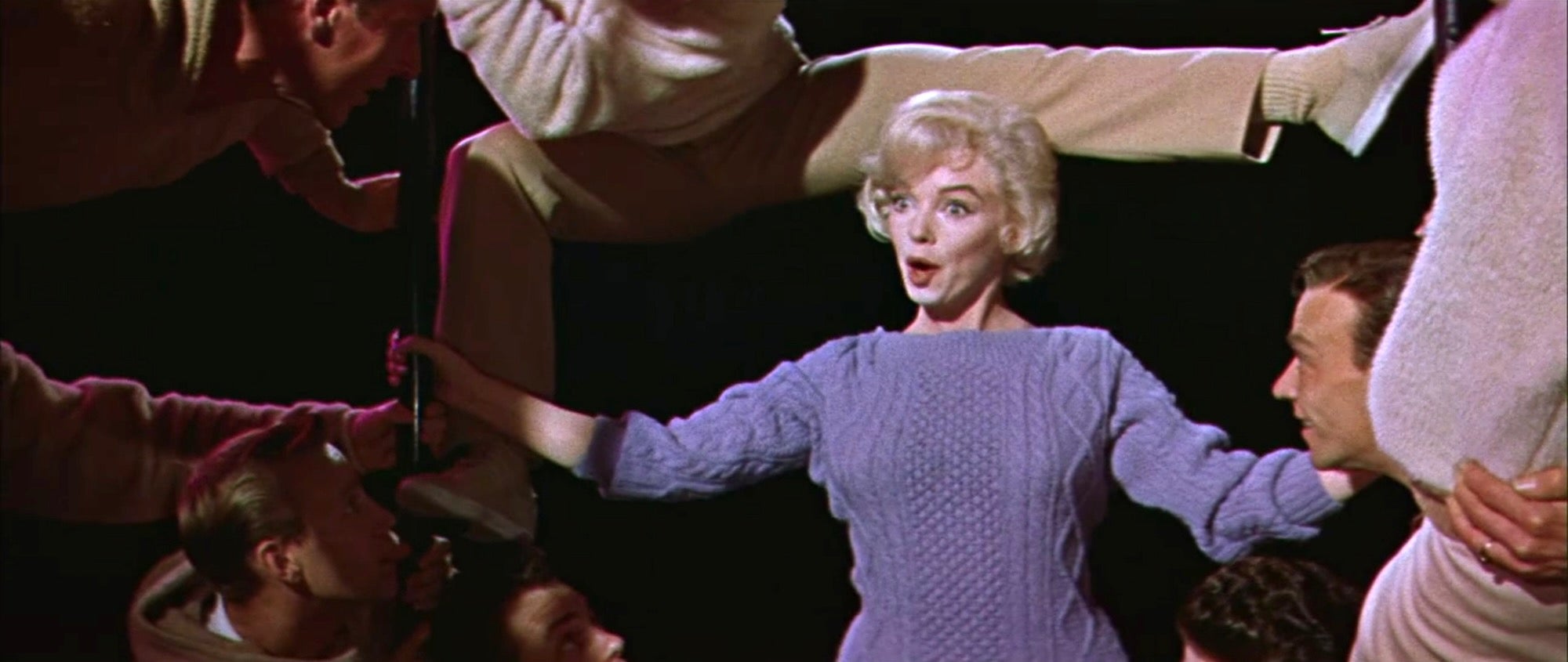
On Monroe, the Aran sweater transforms beyond a functional item of comfort and warmth. Part of that change is due to Monroe’s status in Hollywood as a sex symbol, but it’s also because of the context in which it appears, the result of costume designer Dorothy Jeakins ordering four identical Aran sweaters from a Dublin-based shop. About 15 minutes into Let’s Make Love, Amanda Dell (Monroe) gradually slides down a pole, revealing black tights and her purple Aran sweater before you see her face or hear her sing “My Heart Belongs To Daddy.” The scene also features several male dancers hanging onto her every word and is heavily framed in the male gaze from how Monroe is filmed to reaction shots from the men watching her in the audience. It’s where the film hits its high point (Let’s Make Love is widely considered to be one of Monroe’s lesser movies), but if you want to shake up more the traditional association with the Aran, it’s hard to beat that one.
When McQueen wears an Aran sweater late in the original Thomas Crown Affair, it’s feeding into the persona of McQueen himself as the “King of Cool” and the easiness of Thomas Crown, a high-level banker who recruited several men to rob the bank he worked at simply because he was bored. We’ve already watched Crown pull off the robbery undetected and seduce the insurance investigator (Faye Dunaway) trying to prove he did it without breaking a sweat, so by the time the camera slowly zooms into McQueen wearing the Aran sweater with a baseball cap as he wordlessly smokes a cigar in the driver’s seat of a dune buggy as the score plays over the scene, it’s just another detail to add to McQueen’s aura of cool.
Hollywood influences the runway, usually not the other way around; Monroe’s Aran is a clear example, with The Philadelphia Inquirer Public Ledger giving her and Let’s Make Love credit for “the return of the bulky sweater” in September 1960. According to Truhler, the only time the trend went in the opposite direction was with the debut of Christian Dior’s The New Look in 1947.
“It was Hollywood that was ahead of the curve and the main source of fashion and trend inspiration, just because of the vast number of the millions of people that were going to the movies,” Truhler said. “They had like 90 million people that were going to the movies weekly in 1946. No fashion magazine is ever going to be able to compete with that level of publicity and have it be on people like Rita Hayworth and Marilyn Monroe. The world, it took a long time before there were supermodels or socialites, that mass women wanted to emulate, someone like Meghan, the Duchess of Sussex. People wanted to be like Marilyn. So, almost always, it was the movies that set the trends.”
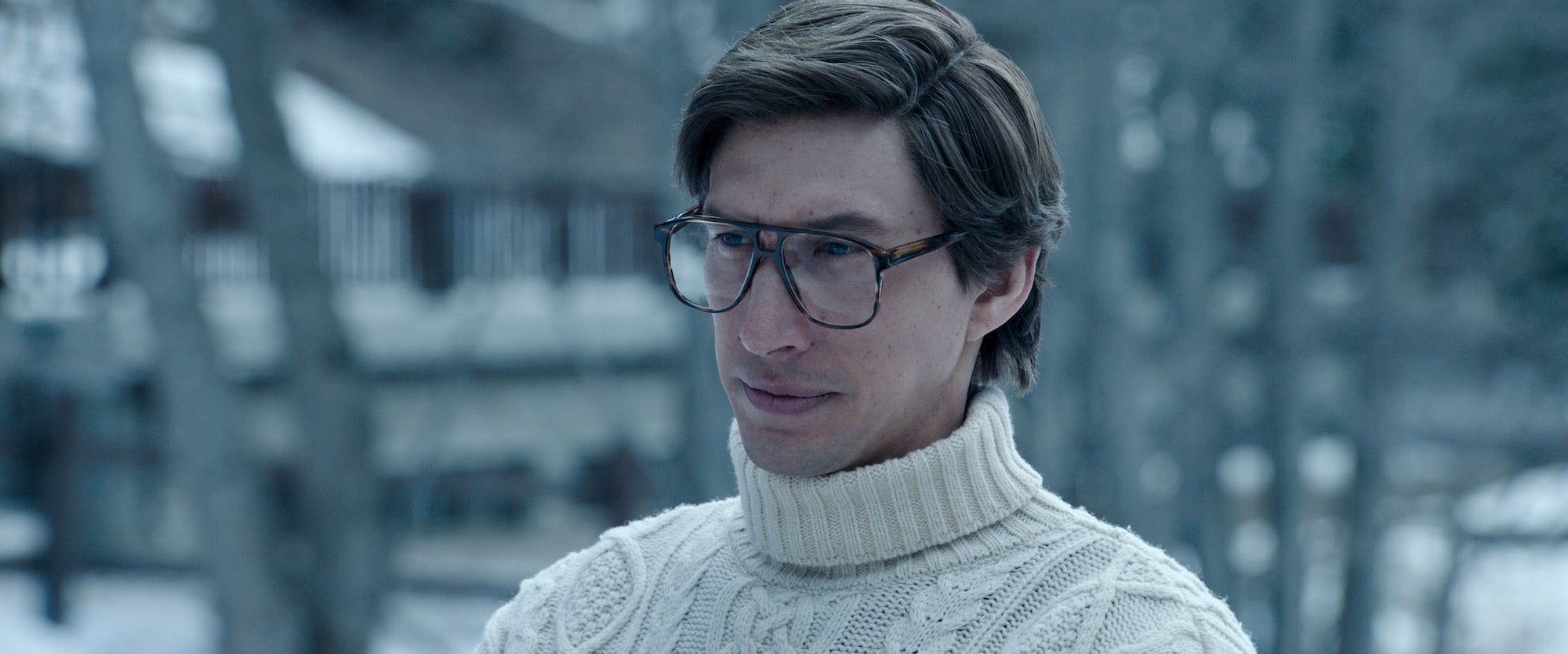
However, the closest famous analog we might have to Maurizio Gucci’s Aran sweater might not come from the movies at all. It’s Grace Kelly, the actor who would leave Hollywood and marry royalty. In February 1962, several years after she became Princess of Monaco, Kelly wore a thick white Aran sweater, sunglasses, and a dark wool hat during a family trip to Gstaad, Switzerland. Many of those photos, some of which showed Kelly sitting on a sled with two of her children, ended up on the cover of several magazines from around the world. Kelly wore an Aran sweater again later in 1962, this time with her hair slicked back and paired with more casual white pants and sneakers while lounging on a sailboat. The end result? A striking image that positions her as a trendsetter.
“There is a rich history of working-class knitting traditions being co-opted for wealthy people for high-fashion purposes,” Kristan said, citing Elsa Schiaparelli’s Trompe L’Oeil bowknot sweater knitted with Armenian colorwork, a Fair Isle sweater worn by Edward VIII in the 1920s, and Monroe’s Cowichan sweater as a few non-Aran examples.
Setting the mood
In the 1970 romance drama Love Story, Oliver Barrett IV, the WASPy lawyer played by Ryan O’Neal, would wear an Aran sweater. It arrives late in the film, making Oliver’s youthfulness even more apparent just before Love Story hurtles toward its tragic ending. It’d be far from the last character swept up (or about to be swept up) in a romance who would wear one.
The chunky white Aran sweater that Harry Burns (Billy Crystal) wears in When Harry Met Sally—the most iconic look in a movie filled with iconic looks—is probably the most famous of these. He’s opening up to Sally (Meg Ryan), who’s wearing a similar-looking sweater in red, about going out on a date for the first time since his divorce. (He also wears it as he flips to the final page of Misery.) It’s a moment of vulnerability, and as much as we may want Harry and Sally to figure their shit out, it’s not quite the right time.
Aran sweaters also show up, albeit in more modernized designs, on Kate Forster (Sandra Bullock) in The Lake House and Amanda Woods (Cameron Diaz) in The Holiday, two 2006 movies with romance at the center. Those sweaters both arrive at a pivotal moment in each film. For Kate, it’s when she and Alex Wyler (Keanu Reeves) realize that they’re both at the exact same place but two years apart. And while Amanda initially puts the sweater on to keep warm in the English cottage she’s staying in, it’s also what she’s wearing when a drunken Graham Simpkins (Jude Law) arrives on her doorstep, expecting his sister to be home and to let him crash for the night.
Renate Reinsve has one on early in the Norwegian film The Worst Person in the World as she moves her things into her boyfriend’s (Anders Danielsen Lie) Oslo apartment when things are going well for them. And even though St. Elmo’s Fire isn’t a romance, the presence of an Aran sweater when Dale Biberman (Andie MacDowell) lets down Kirby Keager (Emilio Estevez) helps it feel like one for a brief moment, even though that framing leaves something of a bitter aftertaste.
They also mostly fall in line with the other narrative that Love Story cemented: It’s an item of clothing associated with wealth or a kind of East Coast fashion, doubling as a rebirth of the preppy chic look. Aran sweaters have shown up in action, romcoms, dramas, crime thrillers, musicals, and whodunits, to name a few genres, and white Aran knits sometimes feed into the idea that the color white can be an indicator of morality. But on the rare occasion that a cinematic cable-knit sweater isn’t white or ivory? That can be a pointed choice, too.
“It’s interesting that, in the cases where that isn’t the basis of the costume design necessarily, like with Elvis and with Marilyn, the color is changed,” Truhler explained. “Normally, they’re all ivory or white. But, to give it more edge, you see Elvis in what I believe is a blue version of the sweater and Marilyn in a purple version of the sweater. So, it’s just meant to seem a little bit edgier, even though they’re wearing the style of the sweater.”
Maurizio’s sweater falls in line with what we’re used to, but the color of his clothing was intentional for another reason.
“That whole ski scene was intentional, it was in the script,” Yates said. “[Maurizio and Paola] were supposed to meet at the bottom of the ski lift, and they’re both wearing white, and either Maurizio or Paola say to each other, they say, ‘Oh, you’re wearing virtually the same ski suit as me. Do we know each other? Were we friends when we were 14?’ but they only kept in the, ‘Were we friends when we were 14?’ They looked very good coming down in the white, and I think it was fairly obvious that they were both wearing white and both skiing like demons.”
Knives Out is a prime example of how our expectations can be used to conceal the twist. Ransom Drysdale’s (Chris Evans) infamously damaged sweater fits right in with the East Coast/New England association, and Evans’ Captain America image feeds into that idea as well. But it’s a cover that helps hide the fact that Ransom is the one who tries to frame Marta (Ana de Armas) and throw her under the bus, as well as the murder of housekeeper Fran (Edi Patterson). And interestingly, the green and brown Aran (or Aran-adjacent) sweaters that show up in Knives Out—a green cardigan by Christopher Plummer’s Harlan Thrombey and a brown pullover with honeycombs centered by Michael Shannon’s Walt Thrombey—are both in color.
Aran’s seemingly eternal appeal
If you look at when those Aran sweater movies came out, you’ll notice that several came out within years or months of each other, only for it not to show up for a while. Even now, House of Gucci isn’t even the only movie released in 2021 to feature cable-knit sweaters: Zack Snyder’s Justice League and The Worst Person in the World also have them, albeit in very different contexts.
If you ask Kristan, the recent resurgence of Aran sweaters is related to a resurgence of a more retro fashion style. With its specific ties to the late ’50s to the early ’70s, it can feel vintage. Kate Atherley, a teacher, designer, and the co-founder of Digits & Threads who’s written eight knitting books, notes that learning how to knit with cables is “a door to a whole world of fun and challenging and engaging and knitting with a great learning curve.”
“When I was a child, I had an Aran sweater, everybody I knew had Aran sweaters, they were usually all home-knitted or they were commissioned from Scotland or from holidays in Scotland,” Yates said. “An Aran sweater is as classic as a Breton sweater.”
“I think it’s about as timeless as you can get,” Truhler said. “And you’ll see modern designers do little things to it from time to time, whether it’s changing up the neckline, changing the length, making the hemline asymmetrical, just to be able to put their design stamp on it. But even when they do that, it just shows its timelessness because we all still recognize that it’s that sweater at its core.”
We’re still waiting on when we’ll be able to obsess over the next sweater. But if previous iterations tell us anything, it’s not if we’ll see another Aran sweater grace the screen but when.
This week’s top culture stories
‘Bridgerton’ needs a queer love story in season 3
‘This honestly scared me’: Madonna’s TikTok slow-zooms into a parody trend
Sign up to receive our newsletter and get the best of the internet in your inbox.
